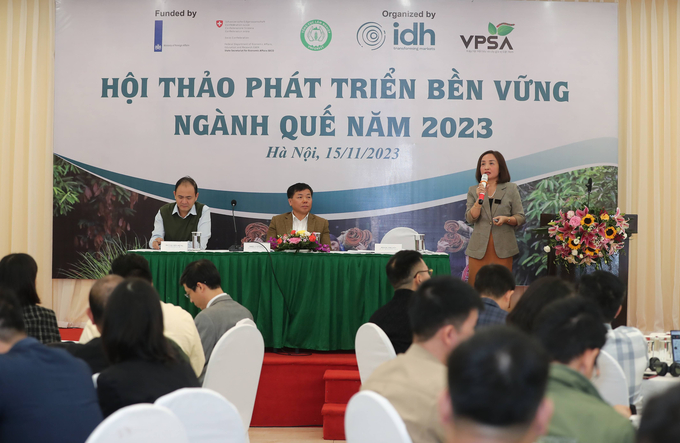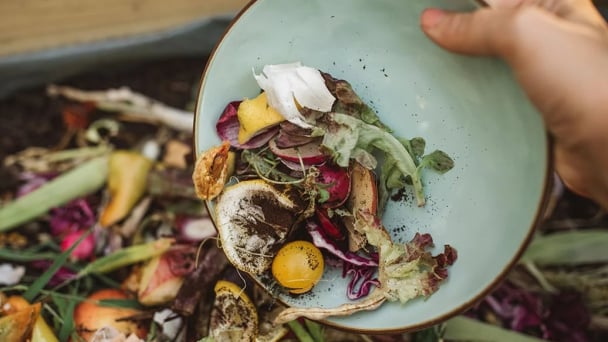May 19, 2025 | 02:17 GMT +7
May 19, 2025 | 02:17 GMT +7
Hotline: 0913.378.918
May 19, 2025 | 02:17 GMT +7
Hotline: 0913.378.918

National workshop "Sustainable development of Vietnam's cinnamon industry" to introduce and launch the Public Private Partnership (PPP) Working Group on pepper and spices, the Cinnamon Industry Subcommittee; discuss the current status and solutions to develop Vietnam's cinnamon industry.
The workshop provided a comprehensive overview of cassia in Vietnam, its challenges, directions, and sustainable development solutions; updates on new market trends related to the EU's "Due Diligence" regulations for exports, new regulations related to exports to the United States. At the event, the organizing board also introduced and launched the Public-Private Partnership (PPP) Working Group on Pepper and Spices, the Subcommittee on Cinnamon Industry, while outlining the strategy for the PPP Group for the period 2024-2025, the vision for 2030, and discussing the roles of public and private sectors, organizations, and project programs in implementing the PPP strategy.
The "Sustainable Development of Vietnam's Cassia Industry" workshop is organized with the participation of nearly 100 delegates from relevant agencies of MARD, VPSA, key cinnamon-growing provinces such as Yen Bai, Lao Cai, Quang Nam, international organizations, Sustainable Spices Initiative (SSI), American Spice Trade Association (ASTA), and numerous domestic and international enterprises in the field of cinnamon production, processing, and trade.
At the workshop, the Department of Forestry representative read out the Decision of the Ministry of Agriculture and Rural Development adjusting the Public-Private Partnership (PPP) Working Group on Pepper to the PPP Working Group on Pepper and Spices. At the same time, they introduced the co-leaders of the PPP Sub-Working Group to the cinnamon industry, including the Forestry Department, VPSA, and IDH. The working group will carry out key activities such as developing a strategy, vision, objectives, and a 5-year and annual action plan for the working group; implementing and monitoring the implementation of the plan, timely adjusting activities, and regularly reporting to the Permanent Secretariat Office of the Partnership on Sustainable Agriculture of Vietnam (PSAV) and the leadership of MARD.
Speaking at the workshop, Mr. Trieu Van Luc, Deputy Director of the Department of Forestry, representing the Working Group, presented the development orientation for the cinnamon industry, which includes the following steps: Identifying land resources and cultivation areas; Improving institutional frameworks, policies, and mechanisms specific to cinnamon; Researching, selecting, cultivating, and producing cinnamon varieties; Developing raw material regions; Organizing production and developing initial processing facilities, manufacturing, and market consumption of products.

Cinnamon and cinnamon products were introduced at the Conference.
During the workshop, ASTA representatives updated the new regulations regarding cinnamon exports to the US market. SSI representatives shared valuable information about the new requirements of the European Union when importing cinnamon, such as regulations related to "Due Diligence." In addition, domestic businesses also shared various models of farmer collaboration in building the cinnamon value chain, highlighting difficulties and proposing interventions.
Mr. Jan Gilhuis, Secretary-General of the Sustainable Spice Initiative (SSI), stated, "Vietnamese cinnamon is an extremely important raw material for SSI members, and SSI is committed and proud to partner with public and private stakeholders to contribute to the sustainable development of the Vietnamese cinnamon industry."
Mr. Huynh Tien Dung – Country Director, IDH Vietnam shared at the event: "The public and private sectors have not just started discussing cooperation and support for the cinnamon industry. In recent times, with the connection of IDH and some non-governmental organizations, the public and private sectors have cooperated to implement many activities such as dialogue, collaboration in building training materials for farmers, coordinating with cinnamon companies to implement many sustainable cinnamon production linkage projects, piloting carbon emission measurement tools in the cinnamon supply chain. However, today's official decision by the MARD has raised the level of public-private cooperation commitment to a new and more comprehensive level."
Vietnam is the 3rd largest producer and exporter of cinnamon in the world. With an area of approximately 180,000 hectares, cinnamon cultivation is currently the livelihood of hundreds of thousands of ethnic minority households in remote provinces, while also contributing to the socio-economic development of many localities. Cinnamon has multiple uses in production and daily life, such as being used as a spice, fragrance, medicinal remedy, ingredient in food processing, animal husbandry, or fertilizer.
In the first 10 months of this year, Vietnam shipped nearly 75,000 tons of cinnamon abroad, earning 220 million USD, becoming the world’s biggest exporter of the product.
Last year, Vietnamese cinnamon accounted for 18.2% in output and 34.4% of the export market share globally.
India is Vietnam’s biggest importer, accounting for some 44% of the market share, followed by the US and Bangladesh.
According to the Vietnam Pepper and Spice Association, Vietnam is lacking a national-level strategy on sustainable development of cinnamon sector.
At a national conference on sustainable development of the cinnamon sector held in Hanoi on November 15, a public-private partnership working group on pepper and spices was established.
Translated by Linh Linh

(VAN) Deputy Minister Nguyen Quoc Tri also expressed his hope that Cuba will soon overcome its current challenges, attain food security, and further expand cooperation with Vietnam.

(VAN) The project contributes to enhancing the resilience of communities vulnerable to the impacts of climate change, with a primary focus on local women.

(VAN) Green materials help save energy and resources. However, after more than 10 years, Vietnam has only developed over 200 green buildings with more than 6 million square meters of floor space.

(VAN) Vietnam - Thailand Business Forum 2025: One plus one on three connects, marking a milestone in the comprehensive strategic partnership between the two nations.

(VAN) The United Nations designated 22 May as the International Day for Biodiversity 2025 with the theme 'Harmony with nature and sustainable development.'
![Multi-channel, multi-directional Vietnamese agricultural markets: [8] A national strategy is needed](https://t.ex-cdn.com/nongnghiepmoitruong.vn/608w/files/phucpm/2025/05/15/1435-thi-truong-nong-san-viet-da-kenh-da-huongbai-8-can-mot-chien-luoc-quoc-gia-084750_728.jpg)
(VAN) The Chairman of Hung Nhon Group shared: ‘Opening up and tapping into new markets is the right and strategic direction for Vietnam's agricultural sector.’

(VAN) Food waste has become a serious issue in modern society, especially in rapidly urbanizing and developing cities like Hanoi.